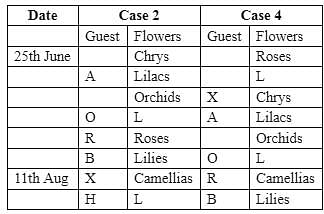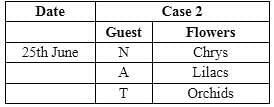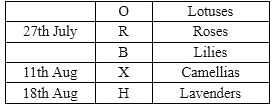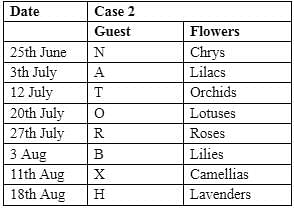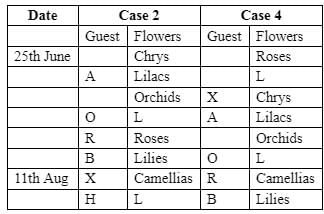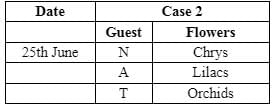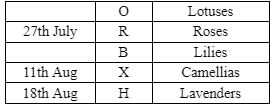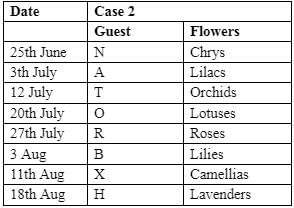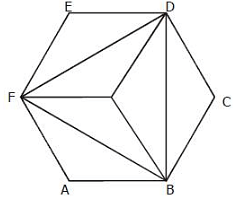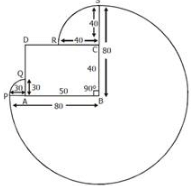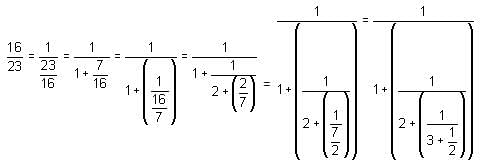CAT Mock Test - 15 (November 17) - CAT MCQ
30 Questions MCQ Test Daily Test for CAT Preparation - CAT Mock Test - 15 (November 17)
Directions: The passage below is accompanied by a set of questions. Choose the best answer to each question.
Literature-poetry, drama, fiction-can be enjoyed in two ways: haphazardly as a layman enjoys it, and methodically as a trained man does. In the one case the impression of its worth is vague, even confused; in the other it is fully accounted for. It is this latter method of enjoying that is called criticism. A critic is an ideal reader. Having 'travelled much in the realms of gold', he brings to bear a trained judgement on whatever he reads. To him no work of art is good or bad, enjoyable or unenjoyable, meaningful or meaningless, unless he has subjected it to a thorough examination. Criticism is, therefore, born of questioning; it never takes a writer or his work on trust. Where a work is held to be divinely inspired or revealed, as in the case of scriptures, there can be no criticism. For orthodox opinion will not permit a free discussion of it. It is the word of God. Hence it is that for long ages after the establishment of Christianity there was hardly any critical literature on the Bible. It was only when the Renaissance encouraged interrogation and free inquiry that it began to be examined critically. Today nothing is sacrosanct to criticism. It subjects everything to the closest scrutiny. Its approach is that of science - a disinterested application to its subject to understand and interpret it fully. For criticism therefore, as for science, to flourish, intellectual freedom is necessary. It requires an atmosphere in which questioning and inquiry are freely allowed.
It is, however, conditioned by many factors, in particular by the trend of the age and the attitude of the critic. Both these tend to limit the critic's freedom as indeed they do that of the writer himself. One is ever a slave to one's times and mental make-up. It is these limitations that make the critical approach of one age or author different from that of another and impart to it its distinctive character. Generally, each age in literary history will be found to have its own critical standards, and each critic his own individual approach. One will look for morality in literature, another for aesthetic pleasure, a third for both. Or, one will advocate conformity to the rules of the Greek and Latin classics, another a reasonable deviation from them, a third a complete freedom of action. And so on. There are, thus, no fixed principles of Criticism to be applied indiscriminately to the works of all ages and writers. What this oft-used phrase actually signifies is the contribution each age has made to critical thought and the course it has followed in so doing. Often the critical canons of one age have been discarded in another and often too, a subsequent age has revived them. So the principles of criticism are nothing more than the various interpretations of literature or literary activity, advanced from time to time. They are sometimes similar, sometimes dissimilar, and sometimes even contradictory.
Q. The writer speaks of an approach 'of science' and 'disinterested application' in the same breath. Why does he do that?
It is, however, conditioned by many factors, in particular by the trend of the age and the attitude of the critic. Both these tend to limit the critic's freedom as indeed they do that of the writer himself. One is ever a slave to one's times and mental make-up. It is these limitations that make the critical approach of one age or author different from that of another and impart to it its distinctive character. Generally, each age in literary history will be found to have its own critical standards, and each critic his own individual approach. One will look for morality in literature, another for aesthetic pleasure, a third for both. Or, one will advocate conformity to the rules of the Greek and Latin classics, another a reasonable deviation from them, a third a complete freedom of action. And so on. There are, thus, no fixed principles of Criticism to be applied indiscriminately to the works of all ages and writers. What this oft-used phrase actually signifies is the contribution each age has made to critical thought and the course it has followed in so doing. Often the critical canons of one age have been discarded in another and often too, a subsequent age has revived them. So the principles of criticism are nothing more than the various interpretations of literature or literary activity, advanced from time to time. They are sometimes similar, sometimes dissimilar, and sometimes even contradictory.
Directions: The passage below is accompanied by a set of questions. Choose the best answer to each question.
Literature-poetry, drama, fiction-can be enjoyed in two ways: haphazardly as a layman enjoys it, and methodically as a trained man does. In the one case the impression of its worth is vague, even confused; in the other it is fully accounted for. It is this latter method of enjoying that is called criticism. A critic is an ideal reader. Having 'travelled much in the realms of gold', he brings to bear a trained judgement on whatever he reads. To him no work of art is good or bad, enjoyable or unenjoyable, meaningful or meaningless, unless he has subjected it to a thorough examination. Criticism is, therefore, born of questioning; it never takes a writer or his work on trust. Where a work is held to be divinely inspired or revealed, as in the case of scriptures, there can be no criticism. For orthodox opinion will not permit a free discussion of it. It is the word of God. Hence it is that for long ages after the establishment of Christianity there was hardly any critical literature on the Bible. It was only when the Renaissance encouraged interrogation and free inquiry that it began to be examined critically. Today nothing is sacrosanct to criticism. It subjects everything to the closest scrutiny. Its approach is that of science - a disinterested application to its subject to understand and interpret it fully. For criticism therefore, as for science, to flourish, intellectual freedom is necessary. It requires an atmosphere in which questioning and inquiry are freely allowed.
It is, however, conditioned by many factors, in particular by the trend of the age and the attitude of the critic. Both these tend to limit the critic's freedom as indeed they do that of the writer himself. One is ever a slave to one's times and mental make-up. It is these limitations that make the critical approach of one age or author different from that of another and impart to it its distinctive character. Generally, each age in literary history will be found to have its own critical standards, and each critic his own individual approach. One will look for morality in literature, another for aesthetic pleasure, a third for both. Or, one will advocate conformity to the rules of the Greek and Latin classics, another a reasonable deviation from them, a third a complete freedom of action. And so on. There are, thus, no fixed principles of Criticism to be applied indiscriminately to the works of all ages and writers. What this oft-used phrase actually signifies is the contribution each age has made to critical thought and the course it has followed in so doing. Often the critical canons of one age have been discarded in another and often too, a subsequent age has revived them. So the principles of criticism are nothing more than the various interpretations of literature or literary activity, advanced from time to time. They are sometimes similar, sometimes dissimilar, and sometimes even contradictory.
Q. All of the following conform to author's point of view presented in the passage, EXCEPT:
It is, however, conditioned by many factors, in particular by the trend of the age and the attitude of the critic. Both these tend to limit the critic's freedom as indeed they do that of the writer himself. One is ever a slave to one's times and mental make-up. It is these limitations that make the critical approach of one age or author different from that of another and impart to it its distinctive character. Generally, each age in literary history will be found to have its own critical standards, and each critic his own individual approach. One will look for morality in literature, another for aesthetic pleasure, a third for both. Or, one will advocate conformity to the rules of the Greek and Latin classics, another a reasonable deviation from them, a third a complete freedom of action. And so on. There are, thus, no fixed principles of Criticism to be applied indiscriminately to the works of all ages and writers. What this oft-used phrase actually signifies is the contribution each age has made to critical thought and the course it has followed in so doing. Often the critical canons of one age have been discarded in another and often too, a subsequent age has revived them. So the principles of criticism are nothing more than the various interpretations of literature or literary activity, advanced from time to time. They are sometimes similar, sometimes dissimilar, and sometimes even contradictory.
Directions: Read the following passage and answer the questions that follow:
Without getting carried away by the wide–eyed protestations of innocence by the modern day Shylocks, there is increasingly lesser doubt that banks have been complicit in precipitating the present imbroglio and what's more, the trail of evidence points towards sins not only of omission, which can be perhaps taken lightly, but explicit sins of commission which cannot be taken lightly. There is also perhaps an increasingly evident undercurrent of resentment against the money lenders within large sections of the population because even though the banks have almost certainly planted the nation head first in this bog of fiscal quagmire, so far they have been appearing to be getting away almost scot–free for their misdemeanors.
That could change pretty soon if the picture emerging from the darkness of the shadows of banking, mortgage sellers, buyers and evaluators is true, and, from the looks of it, it seems that the case is pretty water–tight. The regulators have smelt something fishy and have gone in for in–depth investigation and no, this is not the same as the sub–prime mortgage quicksand but a spin–off of the same with deeper legal ramifications. Despicable, as it may seem, banks are well within their rights to lend to sub–prime borrowers and to go in for foreclosure when regulatory obligations are fulfilled. What cooks the goose is the fact that many home mortgage lenders have resold the loans that they had granted to third and fourth parties through a bidding process.
The loans are clubbed together in a common document which contains the salient characteristics of each loan. The document is then circulated and the loans are sold to the highest bidder. In the current rip–off, the successful bidders evidently got the loans evaluated during the due diligence period and found that many of the loans sanctioned by the primary lender did not pass muster the benchmark and the guidelines set by the merchant himself and instead of bringing it to the notice of the concerned regulators, they preferred to negotiate for lower purchasing prices with the merchant.
The howler was that the secondary buyers did not bring the material information, which could have and would have affected the decision of the investors to park their money in these assets, to the notice of the investors who were buying into these loans and now we have a situation where everyone involved has tried in some manner or the other to keep the next link in the chain in the dark. Here we are, with loans granted without due diligence, being sold to investors who don't have complete information about the same. Had it been based on pure ethical considerations, it might have slid past with just a rap on the knuckles for the offenders but something's got to give in here.
Q. The author's stance on the possibility of financial institutions being found guilty can best be described as
That could change pretty soon if the picture emerging from the darkness of the shadows of banking, mortgage sellers, buyers and evaluators is true, and, from the looks of it, it seems that the case is pretty water–tight. The regulators have smelt something fishy and have gone in for in–depth investigation and no, this is not the same as the sub–prime mortgage quicksand but a spin–off of the same with deeper legal ramifications. Despicable, as it may seem, banks are well within their rights to lend to sub–prime borrowers and to go in for foreclosure when regulatory obligations are fulfilled. What cooks the goose is the fact that many home mortgage lenders have resold the loans that they had granted to third and fourth parties through a bidding process.
The loans are clubbed together in a common document which contains the salient characteristics of each loan. The document is then circulated and the loans are sold to the highest bidder. In the current rip–off, the successful bidders evidently got the loans evaluated during the due diligence period and found that many of the loans sanctioned by the primary lender did not pass muster the benchmark and the guidelines set by the merchant himself and instead of bringing it to the notice of the concerned regulators, they preferred to negotiate for lower purchasing prices with the merchant.
The howler was that the secondary buyers did not bring the material information, which could have and would have affected the decision of the investors to park their money in these assets, to the notice of the investors who were buying into these loans and now we have a situation where everyone involved has tried in some manner or the other to keep the next link in the chain in the dark. Here we are, with loans granted without due diligence, being sold to investors who don't have complete information about the same. Had it been based on pure ethical considerations, it might have slid past with just a rap on the knuckles for the offenders but something's got to give in here.
Directions: Read the following passage carefully and answer the given question.
The expansion of the concept of "person" was perhaps always inevitable. Like the creative definitions of gambling in at least some U.S. states—designed to carve out a legal niche for riverboat casinos while prohibiting the same activity on terra firma—legal personhood for nonhumans was an available loophole that someone was always bound to try to jump through. If you are looking to secure protections for certain beings or environmental features that are otherwise at risk of exploitation, winning the status of person for them is a good way to get what you want.
For a long time, the only way under the law to protect an animal from wanton abuse was to characterize the abuse as harm to property, essentially no different from the sort of law that prevents you from smashing your neighbor's wheelbarrow. As for morality, if it was to enter into question at all, it was indirect incitement to moral depravity brought on by abuse of animals that justified any prohibition on harming them. Thus, philosopher Immanuel Kant insisted it is indeed wrong to harm domestic animals, but this still does not require us to suppose these animals are, as he would say, "ends in themselves." They can only ever be means to distinctly human ends while a child who grows up torturing these "means" is, at worst, going to be more prone to abusing human beings later in life—animal torture as a gateway to human torture—or, at best, is going to be stunted in his or her overall moral development.
In any case, such indirect protection generally only extends to domestic animals while the vast majority of animals belonging to the category we call "wildlife" cannot be protected as property because, by definition, they do not belong to anyone. Over the course of the 20th century, significant subcategories of wildlife would come to be legally protected as part of large-scale conservationist efforts. But the concern here was at the population level rather than the individual and typically implied no commitment to the irreducible worth, however that may be conceived, of any individual member of a given protected species.
For example, gorillas, it appears to many, are sufficiently like human beings in deserving not to be harmed for the same reasons we deserve not to be harmed: not because we belong to someone else and not because our species is at risk of disappearing but because we are—however one might wish to flesh this out in theoretical, metaphysical, or even religious terms—intrinsically worthy beings. The best way to recognize this apparent truth in law has been to reclassify gorillas—perhaps to "promote" them to the status of person as has been done with varying degrees of success in several European countries.
So far, this is the easy part. Again, the case for gorilla personhood has typically been made on the basis of an evident similitude of internal capacities they share with us. Even hippos have what appear to be big smiling faces and plainly love to eat, so they come across as relatable. But no one, at least no one directly involved in modern states' law-making institutions, will make a similar argument for rivers and mountains. Rivers, it is generally believed, have no internal capacities at all. They are not subjects. Yet today, at least some rivers have been reclassified as persons too. To bring such a river harm is to harm a person, a being that ought to be considered an end in itself with inalienable rights and intrinsic worth.
Q. From the passage, it can be inferred that none of the following are true according to Immanuel Kant's view to harm domestic animals EXCEPT that:
Directions: Read the following passage carefully and answer the given question.
The expansion of the concept of "person" was perhaps always inevitable. Like the creative definitions of gambling in at least some U.S. states—designed to carve out a legal niche for riverboat casinos while prohibiting the same activity on terra firma—legal personhood for nonhumans was an available loophole that someone was always bound to try to jump through. If you are looking to secure protections for certain beings or environmental features that are otherwise at risk of exploitation, winning the status of person for them is a good way to get what you want.
For a long time, the only way under the law to protect an animal from wanton abuse was to characterize the abuse as harm to property, essentially no different from the sort of law that prevents you from smashing your neighbor's wheelbarrow. As for morality, if it was to enter into question at all, it was indirect incitement to moral depravity brought on by abuse of animals that justified any prohibition on harming them. Thus, philosopher Immanuel Kant insisted it is indeed wrong to harm domestic animals, but this still does not require us to suppose these animals are, as he would say, "ends in themselves." They can only ever be means to distinctly human ends while a child who grows up torturing these "means" is, at worst, going to be more prone to abusing human beings later in life—animal torture as a gateway to human torture—or, at best, is going to be stunted in his or her overall moral development.
In any case, such indirect protection generally only extends to domestic animals while the vast majority of animals belonging to the category we call "wildlife" cannot be protected as property because, by definition, they do not belong to anyone. Over the course of the 20th century, significant subcategories of wildlife would come to be legally protected as part of large-scale conservationist efforts. But the concern here was at the population level rather than the individual and typically implied no commitment to the irreducible worth, however that may be conceived, of any individual member of a given protected species.
For example, gorillas, it appears to many, are sufficiently like human beings in deserving not to be harmed for the same reasons we deserve not to be harmed: not because we belong to someone else and not because our species is at risk of disappearing but because we are—however one might wish to flesh this out in theoretical, metaphysical, or even religious terms—intrinsically worthy beings. The best way to recognize this apparent truth in law has been to reclassify gorillas—perhaps to "promote" them to the status of person as has been done with varying degrees of success in several European countries.
So far, this is the easy part. Again, the case for gorilla personhood has typically been made on the basis of an evident similitude of internal capacities they share with us. Even hippos have what appear to be big smiling faces and plainly love to eat, so they come across as relatable. But no one, at least no one directly involved in modern states' law-making institutions, will make a similar argument for rivers and mountains. Rivers, it is generally believed, have no internal capacities at all. They are not subjects. Yet today, at least some rivers have been reclassified as persons too. To bring such a river harm is to harm a person, a being that ought to be considered an end in itself with inalienable rights and intrinsic worth.
Q. Which of the following best states the flaw in conservation efforts aimed at 'wildlife' initiated during the 20th century?
Directions: Read the following passage carefully and answer the given question.
The expansion of the concept of "person" was perhaps always inevitable. Like the creative definitions of gambling in at least some U.S. states—designed to carve out a legal niche for riverboat casinos while prohibiting the same activity on terra firma—legal personhood for nonhumans was an available loophole that someone was always bound to try to jump through. If you are looking to secure protections for certain beings or environmental features that are otherwise at risk of exploitation, winning the status of person for them is a good way to get what you want.
For a long time, the only way under the law to protect an animal from wanton abuse was to characterize the abuse as harm to property, essentially no different from the sort of law that prevents you from smashing your neighbor's wheelbarrow. As for morality, if it was to enter into question at all, it was indirect incitement to moral depravity brought on by abuse of animals that justified any prohibition on harming them. Thus, philosopher Immanuel Kant insisted it is indeed wrong to harm domestic animals, but this still does not require us to suppose these animals are, as he would say, "ends in themselves." They can only ever be means to distinctly human ends while a child who grows up torturing these "means" is, at worst, going to be more prone to abusing human beings later in life—animal torture as a gateway to human torture—or, at best, is going to be stunted in his or her overall moral development.
In any case, such indirect protection generally only extends to domestic animals while the vast majority of animals belonging to the category we call "wildlife" cannot be protected as property because, by definition, they do not belong to anyone. Over the course of the 20th century, significant subcategories of wildlife would come to be legally protected as part of large-scale conservationist efforts. But the concern here was at the population level rather than the individual and typically implied no commitment to the irreducible worth, however that may be conceived, of any individual member of a given protected species.
For example, gorillas, it appears to many, are sufficiently like human beings in deserving not to be harmed for the same reasons we deserve not to be harmed: not because we belong to someone else and not because our species is at risk of disappearing but because we are—however one might wish to flesh this out in theoretical, metaphysical, or even religious terms—intrinsically worthy beings. The best way to recognize this apparent truth in law has been to reclassify gorillas—perhaps to "promote" them to the status of person as has been done with varying degrees of success in several European countries.
So far, this is the easy part. Again, the case for gorilla personhood has typically been made on the basis of an evident similitude of internal capacities they share with us. Even hippos have what appear to be big smiling faces and plainly love to eat, so they come across as relatable. But no one, at least no one directly involved in modern states' law-making institutions, will make a similar argument for rivers and mountains. Rivers, it is generally believed, have no internal capacities at all. They are not subjects. Yet today, at least some rivers have been reclassified as persons too. To bring such a river harm is to harm a person, a being that ought to be considered an end in itself with inalienable rights and intrinsic worth.
Q. The author will agree with each of the following statements, EXCEPT that:
Directions: The passage given below is followed by four alternative summaries. Choose the option that best captures the essence of the passage.
When it comes to enjoying life and making full use of it, there is no use looking at the ugly side of things, or grumbling about things not going fine. Instead, rejoice over whatever good things are happening in your life. Even at the age of 80, late actor Dev Anand, used to tell his fans that one should not let oneself be bogged down by the sorrows of life, and instead one must live one's life knowing that it is running out. What matters is your attitude towards the many developments in your daily life. If you take them as challenges, you are a winner; and if you shy away from accepting hard tasks, then you are letting yourself get into a pit that will consume you without letting you do anything good in life.
Directions: There is a sentence that is missing in the paragraph below. Look at the paragraph and decide in which blank (option 1, 2, 3, or 4) the following sentence would best fit.
Sentence: The Covid-19 pandemic gave added urgency to pandemic preparedness and the Indonesian presidency in 2022 made it the major focus.
Paragraph: Health needs to be a central agenda for the G20 2023. The G20 now has health finance in its financial stream and health systems development in the Sherpa stream. ___(1)___. The Indian presidency needs to advance these agendas. Health systems strengthening has engaged the global community in thinking through the content and directions - what is to be strengthened, and how? ___(2)___. The concept of Universal Health Coverage (UHC) was born in the 2000s to prevent catastrophic medical expenditures due to secondary and tertiary level hospital services by universalising health insurance coverage. ___(3)___. The UHC has been the big global approach for health systems strengthening since 2010, also adopted in 2015 as the strategy for Sustainable Development Goal-3 on ensuring healthcare for all at all ages. ___(4)___. However, the limited impact of this narrow strategy was soon evident, with expenditures on outdoor services becoming catastrophic for poor households and preventing access to necessary healthcare and medicines.
Directions: The four sentences (labelled 1, 2, 3, 4) given below, when properly sequenced would yield a coherent paragraph. Decide on the proper sequence of the order of the sentences and key in the sequence of the four numbers as your answer.
1. It is worth noting that, in doing so, a teacher will have to swim against the stream.
2. Any educators interested in or devoted to opening up the world to their students should consider wonder essential to the task, and will do their utmost to foster students' sense of wonder.
3. Wonder epitomises what education is about i.e. opening up the world.
4. Under the current system, an educational climate is created that is inhospitable to instigating a sense of wonder in students.
Directions: The passage given below is followed by four alternative summaries. Choose the option that best captures the essence of the passage.
Although almost all climate scientists agree that the Earth is gradually warming, they have long been of two minds about the process of rapid climate shifts within larger periods of change. Some have speculated that the process works like a giant oven or freezer, warming or cooling the whole planet at the same time. Others think that shifts occur on opposing schedule in the Northern and Southern Hemispheres, like exaggerated seasons. Recent research in Germany examining climate patterns in the Southern Hemisphere at the end of the last Ice Age strengthens the idea that warming and cooling occurs at alternate times in the two hemispheres. A more definitive answer to this debate will allow scientists to better predict when how quickly the next climate shift will happen.
Directions: The following state-wise demographic information is available for the different states in North-East India. This demographic findings is conducted every 5 years, and the latest one was conducted this year in 2016.
Sex Ratio is defined as the number of females per 1000 males.
Birth Rate is the number of live births per 1000 population in a year
Literacy Rate is the percentage of the population who have the ability to read and write.
Each of these figures have been rounded off to the nearest integer.
The Government of India wants to track all these parameters and note key areas where the states have improved in the past 5 years. A higher sex ratio, higher literacy rate, and lower birth rate across this period is what the Government of India wants from these states.
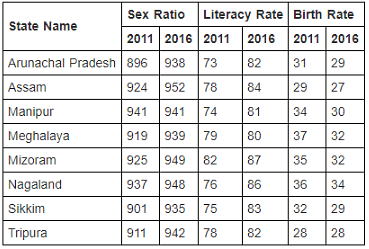
Q. How many states were able to make the Government of India pleased on all three parameters?
Directions: The following state-wise demographic information is available for the different states in North-East India. This demographic findings is conducted every 5 years, and the latest one was conducted this year in 2016.
Sex Ratio is defined as the number of females per 1000 males.
Birth Rate is the number of live births per 1000 population in a year
Literacy Rate is the percentage of the population who have the ability to read and write.
Each of these figures have been rounded off to the nearest integer.
The Government of India wants to track all these parameters and note key areas where the states have improved in the past 5 years. A higher sex ratio, higher literacy rate, and lower birth rate across this period is what the Government of India wants from these states.
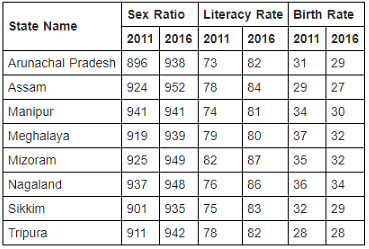
Q. How many of these states saw an increase in the sex ratio figure by more than 3% during the 2011-2016 period?
Directions: The pie charts below show the distribution of yearly expenses of a family for the years 2015-16 and 2014-15.
Total annual expense for the year 2014-15 was 19.2 lakhs and for the year 2015-16 was 25 lakhs.
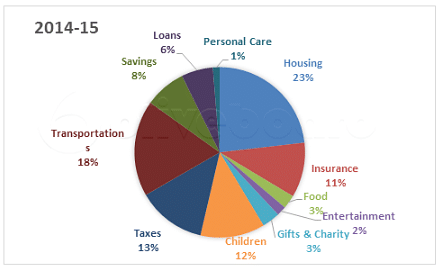
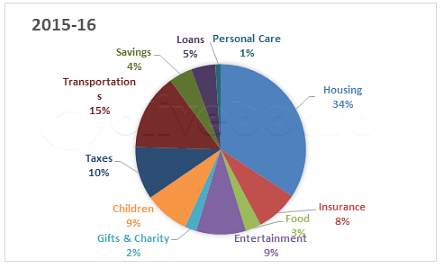
Q. What is the % increase in Housing expenditure for the year 2015-16?
Direction: Answer the questions on the basis of information given below.
The following bar graphs give the data about various districts being affected by natural calamities in the state of Maharashtra for the period 1984 to 1993.
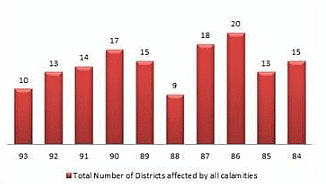

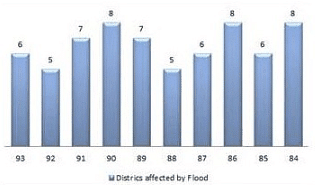
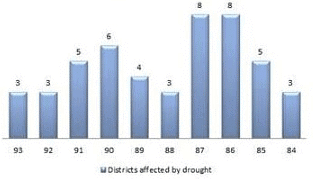
Note: No flood affected district is also a drought affected district.
Q. How many years none of the districts experienced more than one calamity?
Direction: Answer the questions on the basis of information given below.
The following bar graphs give the data about various districts being affected by natural calamities in the state of Maharashtra for the period 1984 to 1993.
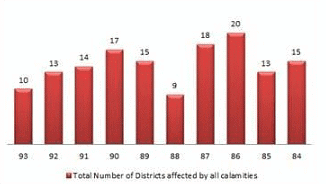
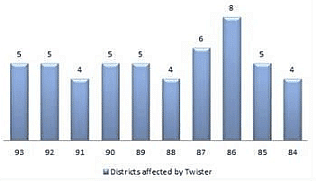
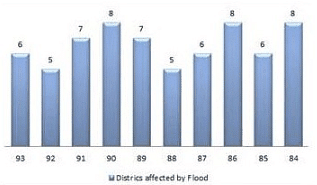
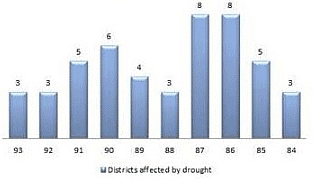
Note: No flood affected district is also a drought affected district.
Q. What is the number of districts affected by twister only over the given 10 years?
Directions: Read the following passage and answer the questions that follow:
Eight dancers were invited as guests in a dance school on different dates of the same year. The number of days between the dates on which any two consecutive guests were invited is more than 5 days but less than 9 days (for example, if P was a guest on 7 November and Q was the guest immediately after P, then Q will be the guest on 14, 15 or 16 November). Each guest was given a bouquet of flowers and the flowers were among roses, lotuses, orchids, lilacs, lilies, camellias, lavenders and chrysanthemums. No two guests were invited on the same day or given the same flowers.
The first guest was invited on 25 June. Three guests were invited between A and B such that A was invited before B. A was given lilacs. There were 13 days in between the dates on which B and O were invited. The one who was invited immediately before O was given orchids. O was not the last guest to be invited. The one who was invited immediately after R was given lilies. R was invited before B. O was not given lilies. There were 14 days in between the dates on which X and the one who was given roses were invited. T was not given roses. There were 8 days in between the dates on which T was invited and the guest immediately before him was invited. The one who was given camellias was invited as a guest on 11 August. H and X were invited in the same month. H was invited before 19 August. T was invited immediately before the one who was given lotuses. There were 7 days in between the dates on which A and the one who was given chrysanthemums were invited. There were more than 7 days in between the dates on which N and the one who was given roses were invited. R was not invited in June.
NOTE: The bouquets were given to the guests such that no two consecutive guests were given flowers whose names start with the letter 'L'.
Q. Who was invited immediately before the one who was given chrysanthemums?
Directions: Read the following passage and answer the questions that follow:
Eight dancers were invited as guests in a dance school on different dates of the same year. The number of days between the dates on which any two consecutive guests were invited is more than 5 days but less than 9 days (for example, if P was a guest on 7 November and Q was the guest immediately after P, then Q will be the guest on 14, 15 or 16 November). Each guest was given a bouquet of flowers and the flowers were among roses, lotuses, orchids, lilacs, lilies, camellias, lavenders and chrysanthemums. No two guests were invited on the same day or given the same flowers.
The first guest was invited on 25 June. Three guests were invited between A and B such that A was invited before B. A was given lilacs. There were 13 days in between the dates on which B and O were invited. The one who was invited immediately before O was given orchids. O was not the last guest to be invited. The one who was invited immediately after R was given lilies. R was invited before B. O was not given lilies. There were 14 days in between the dates on which X and the one who was given roses were invited. T was not given roses. There were 8 days in between the dates on which T was invited and the guest immediately before him was invited. The one who was given camellias was invited as a guest on 11 August. H and X were invited in the same month. H was invited before 19 August. T was invited immediately before the one who was given lotuses. There were 7 days in between the dates on which A and the one who was given chrysanthemums were invited. There were more than 7 days in between the dates on which N and the one who was given roses were invited. R was not invited in June.
NOTE: The bouquets were given to the guests such that no two consecutive guests were given flowers whose names start with the letter 'L'.
Q. On which date was T invited?
Metal A costs Rs. 8.40 per gm and Metal B Rs. 0.21 per gm. In what proportion must these metals be mixed so that gram of the mixture may be worth Rs. 5.67?
Meena scores 40% in an examination and after review, even though her score is increased by 50%, she fails by 35 marks. If her post-review score is increased by 20%, she will have 7 marks more than the passing score. The percentage score needed for passing the examination is
Convert the number 1982 from base 10 to base 12 The result is:
An owner of a pizza stand sold small slices of pizza for Rs. 150 each and large slices for Rs. 250 each. One night he sold 5000 slices, for a total of Rs. 10.50 lakh. How many small slices were sold?
ABCDEF is a regular hexagon of side 6cm. What is the area of the triangle BDF?
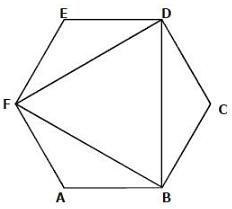
There is a vast grassy farm in which there is a rectangular building of the farmhouse whose length and breadth is 50m and 40m respectively. A horse is tethered at a corner of the house with a tether of 80m long. What is the maximum area that the horse can graze?
If a, b and c are positive integers such that  , then what is the mean of a, b and c?
, then what is the mean of a, b and c?
A dealer offers three successive discounts of 50%, 20% and 10% on an article. What is the single effective discount rate?
Forty per cent of the employees of a certain company are men and 75% of the men earn more than Rs. 25,000 per year. If 45% of the company's employees earn more than Rs. 25,000 per year, what fraction of the women employed by the company earn Rs. 25,000 or less per year?
Arvind Singh purchased a 40 seater bus. He started his services on route number 2 (from Mahu Naka to Dewas Naka with a route length of 50km ). His profit (P) from the bus depends upon the number of passengers over a certain minimum number of passengers 'n' and upon the distance travelled by bus. His profit is Rs. 3600 with 29 passengers in the bus for a journey of 36km and Rs.6300 with 36 passengers in the bus for a journey of 42km. What is the minimum number of passengers are required so that he will not suffer any loss.
A person who has a certain amount with him goes to market. He can buy 50 oranges or 40 mangoes. He retains 10% of the amount for taxi fares and buys 20 mangoes and of the balance, he purchases oranges. Number of oranges he can purchase is:
By what percent should the cost price of an article be marked up such that even after allowing a discount of 50%, a profit of 50% is made?
The reduction in the speed of an engine is directly proportional to the square of the number of bogies attached to it. The speed of the train is 100km/hr when there are 4 bogies and 55kmph when there are 5 bogies. What is the maximum number of bogies that can be attached to the train so that it can move?
|
152 docs|327 tests
|



